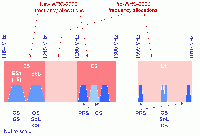If you wish to contribute or participate in the discussions about articles you are invited to contact the Editor
GALILEO Public Regulated Service: Difference between revisions
No edit summary |
|||
| Line 20: | Line 20: | ||
The PRS is operational at all times and in all circumstances, including during periods of crisis. A major PRS driver is the robustness of its signal, which protects it against jamming and spoofing.<ref name="ESA_GALILEO">[http://www.esa.int/esaNA/galileo.html ESA Galileo web page]</ref> | The PRS is operational at all times and in all circumstances, including during periods of crisis. A major PRS driver is the robustness of its signal, which protects it against jamming and spoofing.<ref name="ESA_GALILEO">[http://www.esa.int/esaNA/galileo.html ESA Galileo web page]</ref> | ||
| Line 76: | Line 72: | ||
PRS applications will be used by emergency services, critical transportation, energy or telecom and defence purposes: even if Galileo is the first civilian GNSS in the world, nothing prevents the Member States to use it for military purposes. In this context, the PRS can have important impacts on the Europe's Common Foreign and Security Policy (CFSP) and on the European Security and Defence Policy (ESDP).<ref name="EC GAL web">[http://ec.europa.eu/enterprise/policies/satnav/galileo/index_en.htm EC Galileo website]</ref> | PRS applications will be used by emergency services, critical transportation, energy or telecom and defence purposes: even if Galileo is the first civilian GNSS in the world, nothing prevents the Member States to use it for military purposes. In this context, the PRS can have important impacts on the Europe's Common Foreign and Security Policy (CFSP) and on the European Security and Defence Policy (ESDP).<ref name="EC GAL web">[http://ec.europa.eu/enterprise/policies/satnav/galileo/index_en.htm EC Galileo website]</ref> | ||
Typical applications include: | Typical applications include:<ref name="GALHLD"/> | ||
# Trans-European level | |||
* Law Enforcement (EUROPOL, Customs, European Anti-Fraud Office - OLAF); | |||
* Security Services (Maritime Safety Agency) or Emergency Services (peace keeping forces or humanitarian interventions); | |||
# Member States levels | |||
* Law enforcement; | |||
* Customs; | |||
* Intelligence Services. | |||
==Notes== | ==Notes== | ||
Revision as of 12:41, 12 April 2011
| GALILEO | |
|---|---|
| Title | GALILEO Public Regulated Service |
| Author(s) | GMV |
| Level | Basic |
| Year of Publication | 2011 |
The GALILEO System will be an independent, global, European-controlled, satellite-based navigation system and will provide a number of guaranteed services to users equipped with Galileo-compatible receivers. The GALILEO Public Regulated Service (PRS) provides position and timing restricted to government-authorised users, for sensitive applications which require a high level of service continuity. It will be encrypted and designed to be more robust, with anti-jamming mechanisms and reliable problem detection. This service is intended for security and strategic infrastructure (e.g. energy, telecommunications and finance).[1] [2]
PRS is one of the important features of Galileo that adds value compared to other satellite navigation systems. The access to PRS will be limited to authorised governmental bodies.
Purpose
Galileo is a civil system that also includes a robust and access-controlled service for government-authorised applications. The Public Regulated Service (PRS) will be used by groups such as police, coast-guards and customs. Civil institutions will control the access to the encrypted PRS. Access by region or user group will follow the security policy rules applicable in Europe.
The PRS is operational at all times and in all circumstances, including during periods of crisis. A major PRS driver is the robustness of its signal, which protects it against jamming and spoofing.[3]
Performance and features
The Galileo Public Regulated Service is realized by two signals, one in the 1575.42 MHz band and the other in the 1278.75 MHz band. These signals are encrypted, allowing the implementation of an access control scheme.[3].[4]
The Public Regulated Service access will be controlled by the authorities to be defined at European level, through the encryption of the signals and the appropriate key distribution. The performance objectives in terms of position accuracy and availability are described in next table: [5]
| Galileo Open Service (positioning & timing) | ||
|---|---|---|
| Single Frequency (SF) | Dual Frequency (DF) | |
| Coverage | Global | |
| Accuracy (95%) | Horizontal: 15 m | Horizontal: 4m |
| Vertical: 35 m | Vertical: 8m | |
| Availability | 99.8 % | |
| Timing Accuracy wrt UTC/TAI | 30 ns | |
| Ionospheric Correction | Based on SF Model | Based on DF Measurements |
| Integrity | No | |
To know more information about Performances of each Galileo Service see the article Galileo Performances.
Implementation and PRS Aplications
The Open Service signals are separated in frequency to permit the correction of errors induced by ionospheric effects by differentiation of the ranging measurements made at each frequency. Each navigation frequency will include two ranging code signals (in-phase and quadrature). Data are added to one of the ranging codes while the other “pilot” ranging code is data-less for more precise and robust navigation measurements.
During the Initial Operational Capability (IOC) phase, the GALILEO open service, the search and rescue service and the PRS will be provided. At this stage, however, accuracy and availability will not yet have reached their optimum levels.[1]
PRS applications will be used by emergency services, critical transportation, energy or telecom and defence purposes: even if Galileo is the first civilian GNSS in the world, nothing prevents the Member States to use it for military purposes. In this context, the PRS can have important impacts on the Europe's Common Foreign and Security Policy (CFSP) and on the European Security and Defence Policy (ESDP).[6] Typical applications include:[5]
- Trans-European level
- Law Enforcement (EUROPOL, Customs, European Anti-Fraud Office - OLAF);
- Security Services (Maritime Safety Agency) or Emergency Services (peace keeping forces or humanitarian interventions);
- Member States levels
- Law enforcement;
- Customs;
- Intelligence Services.
Notes
References
- ^ a b Mid-term review of the European satellite radio navigation programmes
- ^ Regulation (EC) No 683/2008 of the European Parliament and of the Council of 9 July 2008 on the further implementation of the European satellite navigation programmes (EGNOS and Galileo).
- ^ a b ESA Galileo web page
- ^ Galileo OS SIS ICD Issue 1 Revision 1 September 2010e
- ^ a b Galileo Mission High Level Definition, v3, September 2002.
- ^ EC Galileo website


